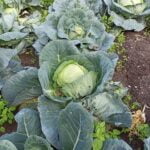Combining vegetable and flower gardens can be a great way to not only maximize your garden space but also create a visually appealing and practical outdoor space. In this article, we will explore the benefits of combining vegetable and flower gardens, and provide tips for designing, planting, and maintaining a successful combined garden.
When planning your garden space, it’s important to consider how you can effectively incorporate both vegetables and flowers. We will discuss various tips for designing a garden that includes both elements, including companion planting, maximizing space, pest control, soil health, aesthetics, and harvesting and maintenance.
Additionally, we will delve into the concept of companion planting – the symbiotic relationships between certain vegetables and flowers that can benefit each other’s growth. By understanding these relationships, you can create a garden that not only looks beautiful but also supports the health and productivity of the plants within it.
Following our discussion on companion planting, we will explore how to make the most of your garden space by utilizing vertical gardening techniques and other space-saving methods. We will also cover natural pest control methods to keep pests at bay in a combined garden setting. So if you’re interested in learning how to successfully combine vegetable and flower gardens while reaping all their benefits, then keep reading.
Planning Your Garden Space
Combining vegetables and flowers in a garden can be a beautiful and practical way to maximize the use of your outdoor space. When planning your garden space, there are several key tips to keep in mind to ensure that both vegetables and flowers thrive in harmony.
First, consider the layout of your garden. When combining vegetables and flowers, it’s important to carefully plan the placement of each type of plant. Some flowers may provide benefits to certain vegetables by attracting beneficial insects or repelling pests, so strategically placing them together can be advantageous. Additionally, consider the height and spread of each plant to avoid overcrowding and competition for sunlight and nutrients.
Another important aspect of designing a combined vegetable and flower garden is selecting the right varieties of plants. Look for vegetables that have similar growing requirements as the flowers you want to include. For example, if you want to combine sunflowers with tomatoes, make sure both plants require similar amounts of sunlight, water, and soil conditions.
Furthermore, when planning your garden space, consider incorporating vertical gardening techniques such as trellises or arbors. This can help maximize space by allowing vining vegetables like cucumbers or squash to grow upwards instead of sprawling across the ground. Additionally, vertical elements can add visual interest to your garden while providing support for climbing flowers like morning glories or sweet peas.
| Benefits | Tips for Designing a Combined Vegetable and Flower Garden |
|---|---|
| Maximizing use of outdoor space | Carefully plan the placement of each type of plant |
| Attracting beneficial insects | Select varieties with similar growing requirements |
| Vertical gardening techniques | Incorporate trellises or arbors for maximizing space |
Companion Planting
Some popular combinations of companion planting in a combined vegetable and flower garden include:
- Tomatoes with marigolds: Marigolds contain a compound that repels nematodes, which can protect the roots of tomato plants.
- Cucumbers with nasturtiums: Nasturtiums attract aphids away from cucumber plants, acting as a natural pest repellent.
- Roses with garlic: Placing garlic around rose bushes can deter aphids and other common pests that can damage roses.
In addition to repelling pests and improving the overall health of the garden, companion planting also promotes biodiversity and attracts beneficial insects such as bees and butterflies. This mutually beneficial relationship between certain vegetables and flowers not only enhances the visual appeal of the garden but also contributes to its overall health and productivity.
When implementing companion planting in a combined vegetable and flower garden, it’s important to research which plant combinations work best together and take into consideration the specific needs of each plant. With careful planning and thoughtful consideration, combining vegetable and flower gardens through companion planting can lead to a harmonious and thriving garden space.
Maximizing Space
Utilizing space-saving techniques in your combined vegetable and flower garden can maximize your harvest and create an aesthetically pleasing oasis. Whether you have a small backyard or a limited area for gardening, vertical gardening can be a game-changer. By growing plants up trellises, fences, or walls, you can take advantage of unused vertical space and free up room for additional planting. Here are some space-saving strategies to consider for your garden:
- Vertical Gardening: Utilize trellises, arbors, and cages to grow climbing vegetables such as cucumbers, tomatoes, and beans vertically.
- Container Gardening: Use containers and hanging baskets to grow flowers and herbs, adding a pop of color while saving ground space.
- Interplanting: Mix fast-growing crops like lettuce or radishes with slower-growing ones like cabbage to optimize the use of space.
In addition to vertical gardening and container gardening, raised beds are another effective way to maximize space in a combined garden. Raised beds allow for better soil drainage and warmer soil temperatures, which can extend the growing season and yield healthier plants. You can also tailor the soil mix in raised beds to suit the specific needs of both vegetables and flowers, creating optimal growing conditions.
When incorporating these space-saving techniques into your garden design plan, be sure to consider the specific sunlight requirements of each plant. Place taller plants at the north end of your garden or raised bed so they don’t shade smaller plants from the sun. By carefully planning your layout, you can make the most of limited space while achieving a beautiful combination of vegetables and flowers in your garden.
Pest Control
When combining vegetable and flower gardens, it’s essential to consider natural pest control methods to keep unwanted critters at bay. One effective way to control pests in a combined garden is through companion planting. For example, planting marigolds alongside vegetables can help repel nematodes and other harmful insects. Additionally, incorporating aromatic herbs like basil and mint can deter pests while also attracting beneficial insects like bees and butterflies.
Another natural pest control method for combined gardens is the use of physical barriers such as row covers or netting. These barriers can protect both flowers and vegetables from birds, insects, and small mammals without the need for chemical pesticides. Additionally, regularly inspecting plants for any signs of pests or disease can help catch potential issues early on before they become widespread.
Furthermore, introducing natural predators into the garden ecosystem can help keep pest populations in check. For instance, encouraging ladybugs, lacewings, and predatory wasps to make a home in your garden can provide a natural defense against common garden pests like aphids and caterpillars. By implementing these natural pest control methods in a combined vegetable and flower garden, you can create a healthy and thriving ecosystem that promotes the growth of both plants.
| Natural Pest Control Methods | Benefit |
|---|---|
| Companion Planting | Repels harmful insects and attracts beneficial insects |
| Physical Barriers | Protects plants from birds, insects, and small mammals |
| Introducing Natural Predators | Keeps pest populations in check without the need for chemical pesticides |
Soil Health
Maintaining the proper balance of nutrients is essential for the success of a combined vegetable and flower garden. Since vegetables and flowers have different nutrient needs, it is important to carefully manage the soil to ensure that both types of plants thrive.
One way to achieve this balance is by conducting a soil test to determine its pH level and nutrient content. This will provide valuable information on what amendments may be necessary to create an optimal growing environment for both vegetables and flowers.
Incorporating organic matter such as compost, manure, or mulch into the soil can help improve its structure and fertility. This will provide essential nutrients for both types of plants without favoring one over the other. Additionally, using cover crops in between planting seasons can improve soil health by preventing erosion, suppressing weeds, and adding nutrients back into the soil as they decompose.
Another important aspect of maintaining soil health in a combined garden is practicing crop rotation. By rotating the location of where different types of plants are grown each season, you can prevent nutrient depletion and reduce the risk of disease buildup in the soil. This practice also helps promote overall soil health and ensures that both vegetables and flowers have access to the nutrients they need to flourish.
Ultimately, maintaining proper soil health is crucial for successfully combining vegetable and flower gardens. By understanding the unique nutrient needs of both types of plants and implementing practices like soil testing, incorporating organic matter, using cover crops, and practicing crop rotation, you can create a balanced growing environment that supports the growth of a variety of vegetables and flowers in harmony.
Aesthetics
Creating a visually appealing garden that combines the practicality of vegetables with the beauty of flowers is not only possible, but it can also be incredibly rewarding. By carefully planning and organizing your garden space, you can create a harmonious and attractive landscape that is both functional and aesthetically pleasing.
Color and Texture
One way to enhance the visual appeal of a combined vegetable and flower garden is to pay attention to color and texture. Utilizing a variety of flowers with different colors, shapes, and sizes can add depth and interest to the garden. Additionally, incorporating vegetables with colorful foliage or unique textures can further enhance the overall aesthetic. Consider planting ornamental varieties of vegetables, such as purple kale or rainbow chard, to add visual interest to your garden beds.
Layout and Design
Careful planning and thoughtful design are essential for creating an attractive and balanced garden. Use techniques like interplanting, where flowers are scattered throughout vegetable beds, as well as edge planting, where flowers frame the perimeter of the garden beds. This can create a seamless transition between the practicality of growing vegetables and the beauty of cultivating flowers.
Container Gardening
For those with limited space or who want to make their patio or balcony more beautiful, combining plants in containers is a great option. You can plant both vegetables like tomatoes or peppers alongside flowers like petunias or marigolds. Vertical gardening using trellises or hanging baskets is also an excellent way to maximize space while adding visual interest to your combined vegetable and flower gardens.
By paying attention to color and texture, carefully planning the layout and design, and utilizing container gardening techniques, you can easily create a visually appealing garden that seamlessly combines both vegetables and flowers. This not only adds aesthetic value to your outdoor space but also enhances the functionality of your garden by creating beneficial companion planting relationships between various species of plants.
Harvesting and Maintenance
When it comes to harvesting and maintaining a combined vegetable and flower garden, there are some important tips to keep in mind to ensure the success of your garden. From proper care and maintenance to maximizing your harvest, here are some helpful guidelines for managing a garden that includes both vegetables and flowers.
Regular Maintenance
One of the keys to a successful combined garden is regular maintenance. This includes tasks such as weeding, watering, and pruning. Regular weeding is essential to prevent unwanted plants from competing with your vegetables and flowers for nutrients and water. In addition, proper watering and pruning will help ensure that your plants stay healthy and productive throughout the growing season.
Harvesting Techniques
Proper harvesting techniques are important when it comes to reaping the benefits of your combined vegetable and flower garden. For vegetables, it’s important to harvest them at their peak ripeness to ensure the best flavor and texture. For flowers, regular deadheading (removing spent blooms) can help encourage continuous blooming throughout the season.
Seasonal Considerations
Different seasons require different maintenance tasks in a combined garden. In the spring, you may need to focus on planting new vegetables and flowers, while in the summer, you’ll need to be diligent about watering and pest control. Fall may bring the need for pruning back certain plants or preparing the soil for next year’s garden. By staying attuned to these seasonal considerations, you can help ensure that both your vegetables and flowers thrive year-round.
By following these tips for caring for and harvesting from a combined vegetable and flower garden, you can enjoy a bountiful harvest of both fresh produce and beautiful blooms throughout the growing season. With proper maintenance and attention to detail, you can create an aesthetically pleasing garden that also provides food for your table – truly getting the best of both worlds.
Conclusion
In conclusion, combining vegetable and flower gardens offers a multitude of benefits and joys for gardeners. Not only does it provide a visually stunning landscape, but it also promotes biodiversity and maximizes the use of garden space. By incorporating both vegetables and flowers, gardeners can create a space that is not only practical but also aesthetically pleasing.
One of the main advantages of combining vegetable and flower gardens is the ability to attract beneficial insects. Flowers such as marigolds, lavender, and sunflowers can attract pollinators and beneficial insects that help control pests in the garden. Additionally, this combination can create a more balanced ecosystem which leads to healthier plants and increased yields.
Furthermore, combining vegetable and flower gardens allows for a more sustainable use of resources such as water, soil nutrients, and gardening materials. By strategically planning the layout of the garden and utilizing companion planting techniques, gardeners can maximize their harvest while minimizing waste. Overall, the synthesis of practicality with beauty showcases the creativity and ingenuity of gardeners who choose to combine vegetable and flower gardens.
Frequently Asked Questions
Can You Mix Flowers and Vegetables in a Garden?
Yes, flowers and vegetables can be mixed in a garden. This practice, known as companion planting, can help create a healthy and balanced ecosystem in the garden. Flowers can attract beneficial insects and pollinators, while vegetables can provide food for the gardener.
What Flowers Go Well With Vegetables?
Some flowers that go well with vegetables include marigolds, nasturtiums, and calendula. Marigolds are known for repelling pests like aphids, while nasturtiums can deter whiteflies and squash bugs. Calendula not only attracts pollinators but also has edible petals.
Can You Plant Flowers and Vegetables in the Same Planter?
Yes, it is possible to plant flowers and vegetables in the same planter. This method is often used in smaller gardens or container gardening. It’s important to select plants with similar water, sunlight, and soil requirements to ensure they thrive together in the same planter space.

If you’re looking to get into vegetable gardening, or are just looking for some tips on how to make your current garden better, then you’ve come to the right place! My name is Ethel and I have been gardening for years. In this blog, I’m going to share with you some of my best tips on how to create a successful vegetable garden.





